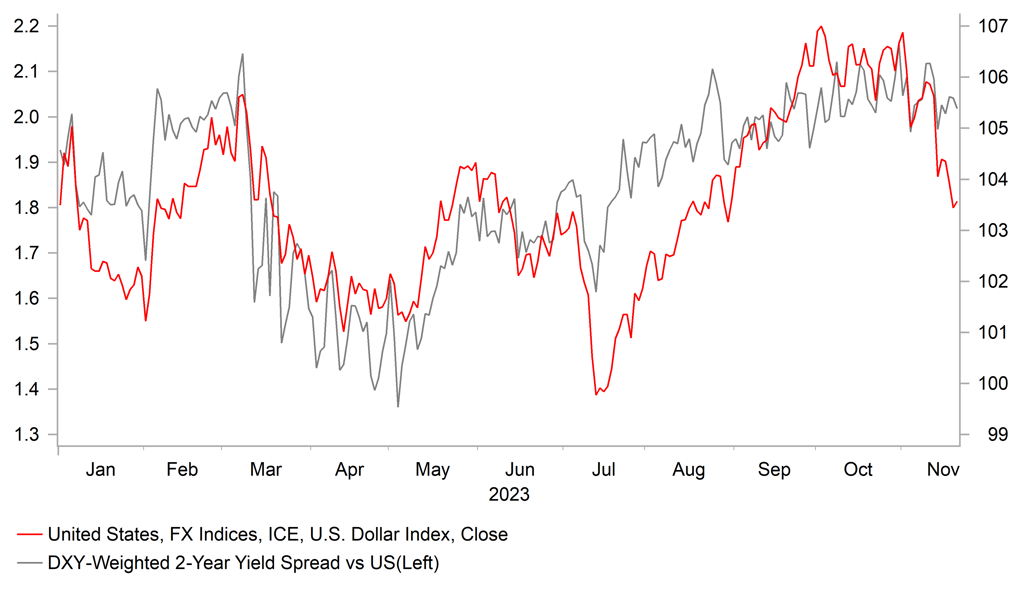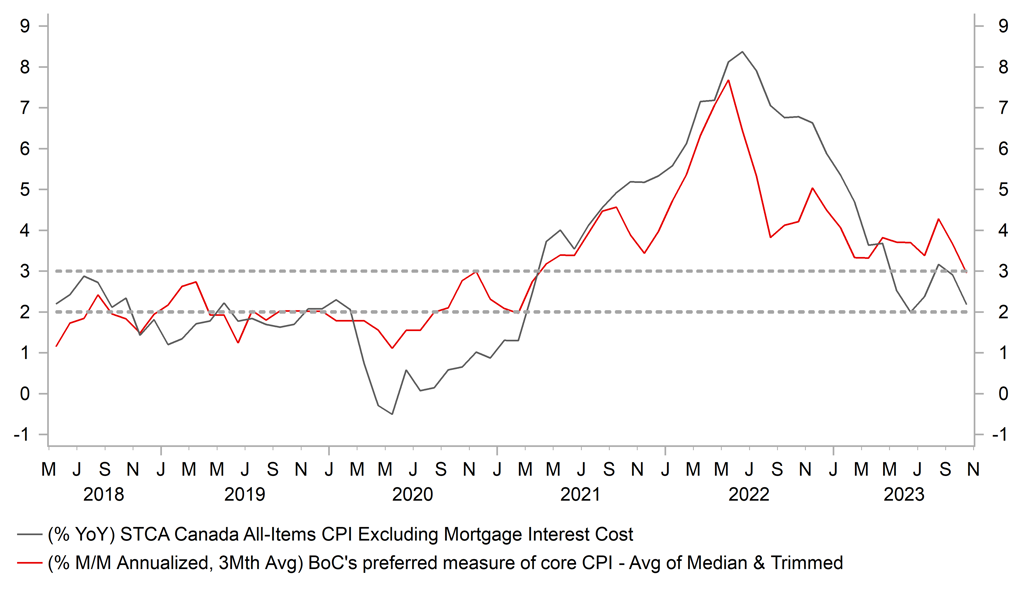USD stages rebound after heavy sell-off
USD: Is the recent USD sell-off overdone?
The US dollar has continued to rebound overnight following heavy selling over the past week. After hitting an intra-day low yesterday of 103.18, the dollar index has risen back up to 103.80 overnight which has lifted it back above support from the 200-day moving average that comes in at around 103.60. It appears to be mainly a US dollar move as US yields have remained stable close to recent lows. The US dollar started to rebound yesterday prior to the release of the latest FOMC minutes, and the move has since extended after the minutes were released. The lack of reaction in the US rate market to the release of the FOMC minutes from the November meeting suggest that US dollar rebound does not mainly reflect a hawkish repricing of outlook for Fed policy. The US rate market is still confident that the Fed has finished their hiking cycle, and is pricing in just over 30bps of cuts by the June meeting of next year and just over 90bps of cuts in total by the end of next year. The minutes revealed that FOMC participants were all in agreement that they should “proceed carefully” and policy decisions at every meeting would continue to be “based on the totality of incoming information”.
Participants indicated that they were expecting incoming data in the coming months “to clarify the extent to which the disinflation process was continuing, aggregate demand was moderating in the face of tighter financial and credit conditions, and labour markets were reaching a better balance between demand and supply”. The release of the softer nonfarm payrolls and US CPI reports since the November FOMC meeting should provide reassurance for the Fed that the disinflation process is continuing and the labour market is reaching a better balance.
The sharp rise in US yields ahead of the November FOMC meeting attracted the attention of FOMC participants. They noted that persistent changes in financial conditions could have implications for the path of monetary policy, and that it would therefore be important to continue to monitor market developments. US yields have since corrected lower with the 10-year US Treasury yield falling back to 4.4% after briefly rising above 5.0% in October. While the recent pullback in US yields and rally in US equities have helped to ease financial conditions, it is unlikely to be sufficient to encourage the Fed to deliver one final hike in December. Market yields are still significantly higher than prior to the summer.
Overall the FOMC minutes have not altered market expectations for Fed policy. The price action in the FX market appears to suggest more that the US dollar had become oversold. The recent move lower for the US dollar has not been fully backed up by yield spreads moving against the US. It is one of the reasons why we have been cautioning against a more extended sell-off in the near-term.
USD HAS MOVED MORE THAN SHORT-TERM YIELD SPREADS

Source: Bloomberg, Macrobond & MUFG GMR
CAD: Slowing inflation reinforces expectations that BoC’s hiking cycle is over
The Canadian dollar has underperformed alongside the US dollar this month. It has extended the Canadian dollar’s decline against a basket of equally-weighted G10 currencies to around -3.3% since the peak from late September when the price of Brent hit a high of USD97.69 on 28th September. The price of oil has since corrected sharply lower fully reversing initial gains recorded following the start of conflict between Hamas and Israel, and falling to the lowest level since July as it moves back towards year to date lows recorded between USD70 and USD75/barrel. Recent weakness in the price of oil has encouraged speculation that the OPEC+ will act to cut supply again to dampen downward pressures on prices from fears over slowing global growth. OPEC+ members are scheduled to meet on 26th November in Vienna. Saudi Arabia is currently expected to extend their 1 million barrel/day oil supply cuts into early 2024 that was introduced over the summer. OPEC+ member would have to announce deeper or more prolonged than expected supply cuts to provide more support for the price of oil, and help to ease Canadian dollar selling pressures.
At the same time, the recent underperformance of the Canadian dollar has been driven by the dovish repricing of the outlook for BoC policy. The implied yield on the December 2024 3-month interest futures contract from Canada has fallen by 0.80 points to around 4.50% since peaking in early October. Market expectations that the BoC have ended their rate hike cycle were supported by the release yesterday of the latest CPI report from Canada. The report revealed that the annual rate of headline inflation fell sharply by 0.7 point to 3.1% in October. In seasonally adjusted terms, headline inflation fell by 0.1%M/M which was the first monthly decline since early in 2020. The headline rate of inflation was driven down by a -6.4% decline in the price of gasoline. Furthermore it was reassuring that the BoC’s measures of core inflation increased at a slower pace for the second consecutive month. The average of the median and trimmed-mean measures slowed to an annual rate of 3.6% in October, and has increased on average over the last three months by an annualized rate of 3.0%. After stripping out the impact of rising mortgage interest rate costs, inflation is even running at just over 2%. The combination of slowing inflation and a stagnating economy is fuelling speculation that the BoC will begin to cut rates from Q2 of next year. Despite the relative resilience of the US economy, the US rate market is still pricing in around 0.2 point of further cuts than the BoC by the end of next year. With the Canadian rate market currently pricing in around 75bps of cuts, it leaves room for further BoC cuts to be priced into next year which should remain a weight on Canadian dollar performance going forward. As a result, we expect USD/CAD to continue to trade in the high 1.3000’s. Governor Macklem is scheduled to speak alter today on the “cost of high inflation”. Market participants will be wary of any pushback against the recent dovish repricing of the BoC policy outlook.
INFLATION IS SLOWING BACK INTO LINE WITH BOC’S TARGET

Source: Bloomberg, Macrobond & MUFG GMR
KEY RELEASES AND EVENTS
|
Country |
GMT |
Indicator/Event |
Period |
Consensus |
Previous |
Mkt Moving |
|
AU |
08:35 |
RBA Gov Bullock Speaks |
-- |
-- |
-- |
! |
|
UK |
09:00 |
BoE Financial Stability Report |
-- |
-- |
-- |
!! |
|
EC |
09:00 |
ECB Financial Stability Review |
-- |
-- |
-- |
!! |
|
UK |
10:00 |
Autumn Forecast Statement |
-- |
-- |
-- |
!!! |
|
US |
13:30 |
Durable Goods Orders (MoM) |
Oct |
-3.1% |
4.7% |
!! |
|
US |
13:30 |
Initial Jobless Claims |
-- |
225K |
231K |
!!! |
|
US |
15:00 |
Michigan 5-Year Inflation Expectations |
Nov |
3.2% |
3.0% |
!! |
|
CA |
16:45 |
BoC Gov Macklem Speaks |
-- |
-- |
-- |
!! |
Source: Bloomberg
